Slaying the demon in our everyday lives may seem impossible and daunting, yet there is always the triumph over evil and the power of the demon can be crushed. Such a great day calls for celebration. The Hindus mark the fourteenth day of the dark fortnight of Ashwin as Narak Chaturdashi.
The story behind the celebration of Narak Chaturdashi
The legend behind this festival is interesting. On this day, Shri Krishna returned home at dawn after slaying the demon, Narkasur, with a tilak of the demon’s blood on his forehead. His father Nanda gave him an auspicious bath. The women moved lighted lamps around Krishna’s face, expressing their joy. Since then, it is believed that the one who takes an auspicious bath on this tithi will not suffer in hell. Also, lighting lamps on this day can destroy tamsik energies.
The day is also popularly celebrated as Choti Diwali or Roop Chaudas.
Know all about Narkasur
Narkasur was a powerful demon who harassed both deities and people. He imprisoned 16,000 young princesses with an intention of marrying them after winning their kingdom in battles. There was a chaos in a place named Pragjyotishpur ruled by him. On hearing all this, Shri Krishna attacked the demon, slayed him and set the princesses free.
What is Kali Chaudas
This day is also celebrated as Kali Chaudas. At some places, it is believed that goddess Kali killed Narkasur. That’s why people there offer oil, flowers, sweets, camphor, agarbatti, diyas, coconut and aarti to the goddess with a desire that Maa Kali will bring real light into their life and eliminate wickedness.
How is Narak Chaturdashi celebrated?
The celebration begins a day before Chaturdashi from midnight. It is believed that after 12 o’ clock midnight, the atmosphere starts getting polluted and tamsik energies start generating. Hence, one has to bathe early before sunrise or during moonrise, light ghee lamps in earthen pots and worship almighty ritualistically. An ubtan made up of til oil, flowers, herbs and many more essential elements is applied on the body as a ritual during taking the holy bath. It is believed that someone who doesn’t perform this ritual goes to hell.
On the day of Narak Chaturdashi, one should also make an offering to Yamraj to overcome untimely death. For this, he/she should consult the religious almanac and then perform puja rituals in a precise way. At some places, the mother moves lighted lamps around the face of their children. Some even break ‘Karit’ a bitter fruit with their toes to mark the slaying of Narkasur.
Offering meal to a Brahman is also considered to be auspicious on Narak Chaudas. According to Hinduism, feeding a Brahman means paying gratitude to God. In the evening, a piece of cloth is offered to God with a belief to invoke the occurrences of deities to descend on earth.
To avoid going to hell and to get cleansed from sins, a lamp with four wicks should be lit in the ritualistic worship that is performed 72 minutes after sunset (pradosh kaal). Ceremonial worship of destroyer form of God ‘Lord Shiva’ is also performed on Narak Chaturdashi.
At some places, an effigy of Narkasur is burnt in public places. However, no scriptures have mentioned burning of the demon’s effigy. This practice only cause pollution and create traffic hazards on the roads.
Sometimes, many people are seen getting involved in bad things like staying awake at night, consuming alcohol and indulging in vulgar dances. This can have an adverse impact on the society. There are no spiritual benefits of such practices. Rather, such activities increase the influence of negative energies.
Think about the significance of the festival and celebrate it in an environment-friendly way.











